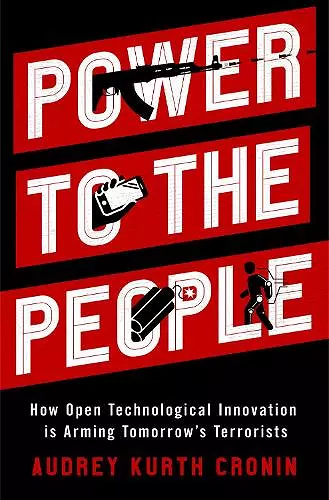Power to the People
How Open Technological Innovation is Arming Tomorrow's Terrorists
Format:Hardback
Publisher:Oxford University Press Inc
Published:23rd Jan '20
Currently unavailable, and unfortunately no date known when it will be back
This hardback is available in another edition too:
- Paperback£19.49(9780197578933)

Never before have so many possessed the means to be so lethal. The diffusion of modern technology (robotics, cyber weapons, 3-D printing, autonomous systems, and artificial intelligence) to ordinary people has given them access to weapons of mass violence previously monopolized by the state. In recent years, states have attempted to stem the flow of such weapons to individuals and non-state groups, but their efforts are failing. As Audrey Kurth Cronin explains in Power to the People, what we are seeing now is an exacerbation of an age-old trend. Over the centuries, the most surprising developments in warfare have occurred because of advances in technologies combined with changes in who can use them. Indeed, accessible innovations in destructive force have long driven new patterns of political violence. When Nobel invented dynamite and Kalashnikov designed the AK-47, each inadvertently spurred terrorist and insurgent movements that killed millions and upended the international system. That history illuminates our own situation, in which emerging technologies are altering society and redistributing power. The twenty-first century "sharing economy" has already disrupted every institution, including the armed forces. New technologies are transforming access to the means of violence. Just as importantly, higher-order functions that previously had been under state military control (mass mobilization, force projection, and systems integration) no longer are. Cronin closes by focusing on how to respond so that we both preserve the benefits of emerging technologies yet reduce the risks. Power is flowing to the people, but the same technologies that empower can imperil global security, unless we act strategically.
Rather than broadly faulting emergent lethal technologies, [Cronin] makes a very focused and compelling case for attending to the threats posed by open-source 'off-the-shelf' technologies that are affordable and easily operated, and are easily weaponized (3D-printed guns and the arming of inexpensive hobby drones are two relevant examples)... Cronin invites readers to consider specific case studies in which similar emergence, diffusion, and affordability of lethal technology fomented and enabled unanticipated terrorist activity. * Science *
In this meticulously researched book, Cronin shows how groups such as the Islamic State (or isis) exploit new technologies such as the Internet, smartphones, autonomous vehicles, and artificialintelligence. * Lawrence D. Freedman, Foreign Affairs *
- Winner of Winner of the 2020 Neave Book Prize.
ISBN: 9780190882143
Dimensions: 163mm x 234mm x 28mm
Weight: 726g
440 pages